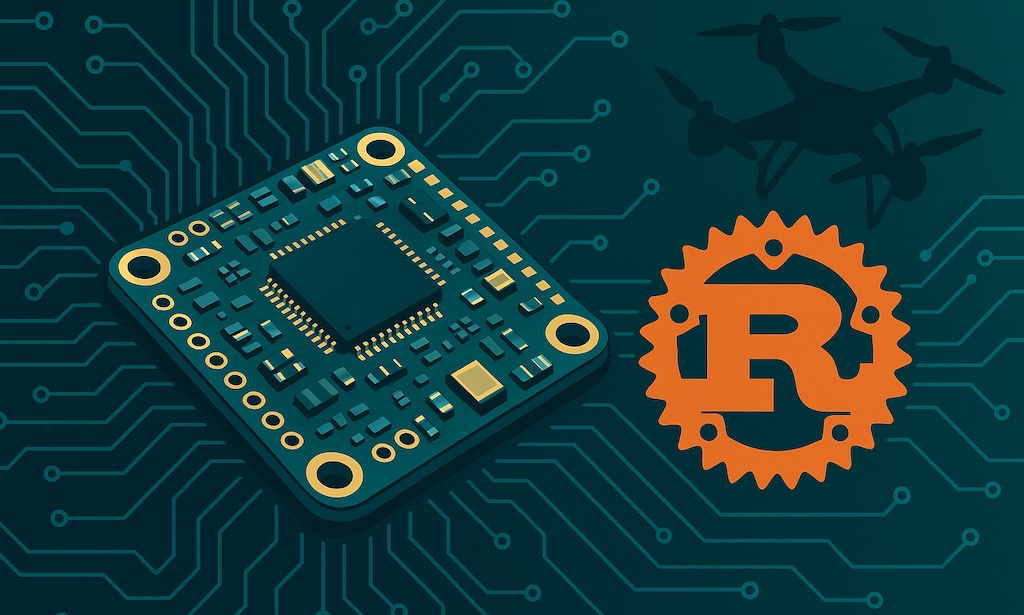Affordable Flight Controllers for Rust Development
I recently explored flight controllers to support my Rust-based flight stabilizer project. For flight controllers, Rust’s ‘zero-cost abstractions’ and compile-time safety checks provide the reliability of higher-level languages with the performance and resource efficiency of C/C++.
To keep the project as accessible as possible, I avoided higher-priced PX4-based boards (professional-grade flight controllers that often start at $200+), though I don’t preclude supporting them in the future.
My primary criteria were:
- Robust Rust ecosystem support (including strong HAL and board support crates)
- Integrated sensors including at least an integrated 6-axis IMU and barometer for reduced build complexity
- Affordability to keep the project accessible
Fortunately, most modern flight controllers use ARM processors, which benefit from a mature, community-supported Rust ecosystem due to widespread industry adoption. After extensive research, I’ve identified several promising options that meet these criteria:
Teensy® 4.0
- Processor: ARM Cortex-M7 @ 600 MHz
- Memory: 1,984 KB Flash, 1,024 KB RAM (512 KB tightly coupled)
- Cost: ~$24 USD (without sensors)
The Teensy 4.0 delivers impressive processing power at an attractive price point. Its 600 MHz Cortex-M7 processor excels at computationally intensive tasks like real-time signal processing and complex flight algorithms. However, its general-purpose design requires manually integrating external sensors (IMU, barometer, etc.), increasing total cost, adding complexity, and potentially introducing inconsistencies between builds. Teensy boards have solid Rust support through the teensy-rs project, though it’s not as mature as support for some STM32 boards.
SpeedyBee F405 Wing App
- Processor: STM32F405 @ 168 MHz
- Memory: 1 MB Flash, 192 KB RAM
- Sensors: Integrated ICM-42688-P IMU, SPL06-001 barometer
- Connectivity: Built-in WiFi and Bluetooth
- Cost: ~$40 USD
The SpeedyBee F405 Wing App offers exceptional value, striking an ideal balance between functionality and affordability. Despite its modest price point, it includes high-quality integrated sensors (the ICM-42688-P IMU and SPL06-001 barometer) that eliminate the need for external components, significantly simplifying the prototyping process. Its built-in WiFi and Bluetooth connectivity provide convenient options for configuration, firmware updates, and real-time monitoring—features typically found in more expensive controllers. While its processing power is lower than the H743-based options, the F405 processor provides sufficient performance for standard flight control algorithms, making this board particularly attractive for those prioritizing quick implementation and budget constraints.
Matek Wing H743 V3
- Processor: STM32H743VIT6 @ 480 MHz
- Memory: 2 MB Flash, 1 MB RAM
- Sensors: Integrated ICM-42688-P IMU, DPS310 barometer
- Additional Features: MicroSD support
- Cost: ~$100 USD
The Matek Wing H743 V3 represents a significant step up in capability, justifying its higher price point with premium performance characteristics. Its powerful 480 MHz processor delivers nearly three times the processing power of the SpeedyBee F405, while its generous 1 MB of RAM and 2 MB of flash memory provide substantial headroom for complex flight algorithms and data logging. The integrated high-quality sensors (ICM-42688-P IMU and DPS310 barometer) offer reliable flight data, and the MicroSD support enables extensive logging capabilities essential for development and debugging. Its exceptional performance and expandability make it an ideal foundation for advanced Rust-based flight control systems with long-term development potential.
Holybro Kakute H743 Wing
- Processor: STM32H743 @ 480 MHz
- Memory: 2 MB Flash, 1 MB RAM
- Sensors: Integrated BMI270 IMU, BMP280 barometer
- Connectivity: Integrated OSD, multiple UARTs
- Cost: ~$90 USD
The Holybro Kakute H743 Wing is powered by the same high-performance 480 MHz STM32H743 processor and equipped with identical memory specifications as the Matek board. Where the Kakute differentiates itself is in its sensor package, featuring the BMI270 IMU and BMP280 barometer—reliable components with strong community support in the Rust ecosystem. With its comprehensive UART options facilitating flexible peripheral connections and a $10 savings compared to the Matek, the Kakute H743 represents an excellent balance of high-end performance and value.
Final Decision
After careful consideration, the Matek Wing H743 V3 and Holybro Kakute H743 Wing emerged as equally compelling options. Both boards deliver similar performance—boasting high clock speeds (480 MHz), generous RAM (1 MB), and substantial flash memory (2 MB). They differ primarily in their sensor packages and additional features. While they’re pricier than the SpeedyBee or Teensy, their power and expandability justify the cost for a sophisticated flight stabilizer. The Holybro’s pre-soldered PWM header option (when available) is a nice touch, but the Matek’s immediate availability tipped the scales. Ultimately, I chose to target the Matek Wing H743 V3 to kick off development, though supporting both boards wouldn’t be difficult down the line.
Flight Controller Comparison Table
| Feature | Teensy 4.0 | SpeedyBee F405 Wing App | Matek Wing H743 V3 | Holybro Kakute H743 Wing |
|---|---|---|---|---|
| Processor | ARM Cortex-M7 @ 600 MHz | STM32F405 @ 168 MHz | STM32H743VIT6 @ 480 MHz | STM32H743 @ 480 MHz |
| Flash Memory | 1,984 KB | 1 MB | 2 MB | 2 MB |
| RAM | 1,024 KB (512 KB tightly coupled) | 192 KB | 1 MB | 1 MB |
| Integrated IMU | None (requires external) | ICM-42688-P | ICM-42688-P | BMI270 |
| Integrated Barometer | None (requires external) | SPL06-001 | DPS310 | BMP280 |
| Special Features | Smallest form factor | Built-in WiFi & Bluetooth | MicroSD support | Integrated OSD, multiple UARTs |
| Rust Support | Good (via teensy-rs) | Excellent (mature STM32 ecosystem) | Excellent (mature STM32 ecosystem) | Excellent (mature STM32 ecosystem) |
| Approximate Cost | $24 USD (+ sensor costs) | $40 USD | $100 USD | $90 USD |
